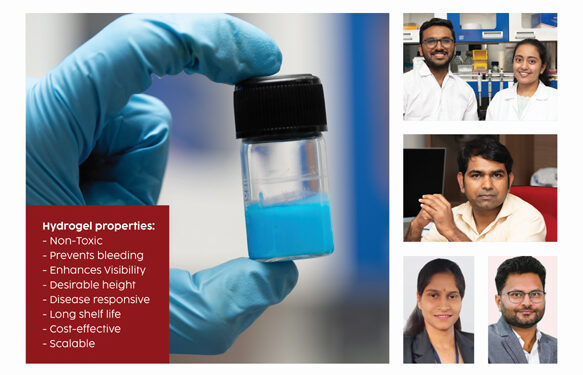- This novel, made-in-India hydrogel platform provides a stable cushion for endoscopic procedures targeting GIT cancers, augmenting precise and safe treatments
- In addition to aiding in the early detection and treatment of such cancers, this innovation could potentially transform the future of disease-responsive smart drug delivery systems
- The risk of damaging the healthy tissue around tumours during chemotherapy or via standard surgical procedures like Endoscopic Submucosal Dissection (ESD) is a major concern: Prof Mukesh Dhanka, an Assistant Professor at IIT Gandhinagar’s Department of Biological Sciences and Engineering and Principal Investigator of the study
GOWRI MANICKAVASAGAM
GANDHINAGAR, NOV 15
In a recent study published in Small, a research team from the Indian Institute of Technology Gandhinagar (IITGN) presented a promising innovation using injectable hydrogels in the early detection and treatment of gastrointestinal tract (GIT) cancers. The injected material is gel-like and can maintain its cushion-like structure while holding large volumes of water. This technology is designed to improve endoscopic procedures for GIT cancers.
Over recent decades, the incidence of cancers within the GIT — including colorectal, stomach, and oesophageal cancers — has risen globally, posing a significant health concern across all demographics. Treating these cancers, which might arise as small growths called polyps, is challenging due to the GIT’s delicate and layered structure. “The risk of damaging the healthy tissue around tumours during chemotherapy or via standard surgical procedures like Endoscopic Submucosal Dissection (ESD) is a major concern,” explained Prof Mukesh Dhanka, an Assistant Professor at IIT Gandhinagar’s Department of Biological Sciences and Engineering and Principal Investigator of the study.
To make ESD safer and more effective, doctors inject fluid beneath the polyp, forming a “cushion.” This raises the polyp slightly, separating it from healthy tissue and making it easier to remove without cutting too deep. Few traditional submucosal injection solutions (SISs) provide temporary support but can diffuse quickly and require multiple injections. Hydrogels have been noted as potential replacement candidates for submucosal cushions due to their stability and capability of supporting the polyp for the duration of the ESD. Despite these advantages, many are too viscous to inject through the long catheters used in these procedures.
“We attempted to combat these pertinent issues by developing a novel hydrogel platform that is economical, versatile, and non-toxic to humans,” said Mr Harshil Dave, a PhD student and co-first author of the study. The team created the hydrogel using diglycerol monostearate (DGMS), a plant-based molecule that self-assembles. “DGMSH’s ‘shear-thinning’ property allows it to flow easily under pressure and return to a gel-like state once the pressure is released, making it perfect for delicate endoscopic procedures,” added co-first author and PhD student Ms Hitasha Vithalani. “This behaviour allows smooth clog-free injections through a range of catheter needles, forming a long-lasting cushion beneath polyps.”
The team also leveraged the DGMS molecule’s amphiphilic properties. Amphiphiles have two distinct affinities: hydrophilic (water-loving) and hydrophobic (water-hating). This duality allowed the molecules of the hydrogel to self-assemble into a mesh-like structure that can interact with anti-cancer drugs and other small molecules, such as blood clotting agents and dyes. DGMSH’s capability to encapsulate various drugs could promote its use as a taxi that delivers anti-cancer medicines directly to a polyp, ensuring the safety of nearby tissues.
“In addition to cellular studies, we tested the hydrogel and its efficacy in various animal models,” said Dr Indu Yadav, a postdoctoral fellow attached to the team. In experiments with rats and porcine models, the team successfully created a DGMSH cushion that supported the endoscopic removal of polyps, controlled bleeding, and allowed for efficient resection. Dr Abhinav Jain, a gastroenterologist associated with the study, believes that despite DGMSH’s early stages, its effectiveness, scalability, long shelf life, and affordability make it a potential multipurpose tool for gastrointestinal treatments.
“We have filed a patent application related to this study and are applying for funding to undertake clinical trials in the near future,” said Prof Dhanka. His research group at IITGN’s Biomaterials and Drug Delivery Lab works to find creative, scalable solutions for global biomedical challenges. The team is currently looking into expanding on some aspects of this study to create targeted therapeutics for GIT disorders, cancers, diabetes, and other ailments. They envision the technology could pave the way for new therapies with fewer side effects, increased precision, and better patient response.









